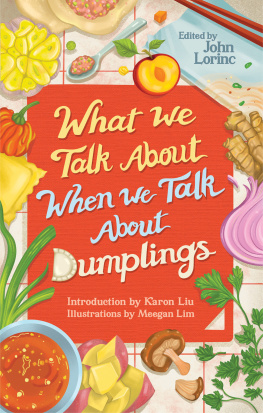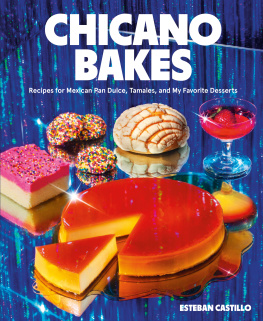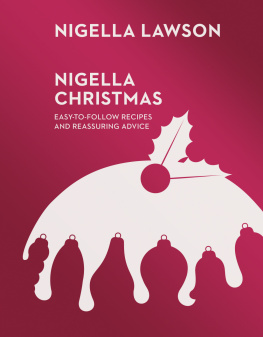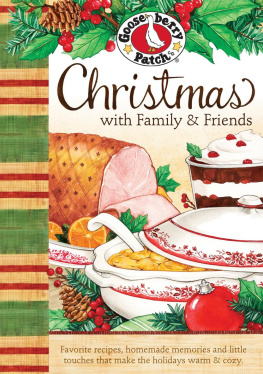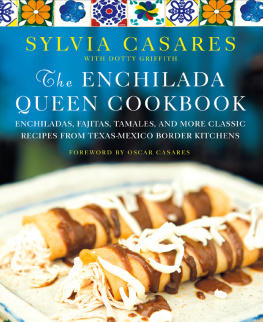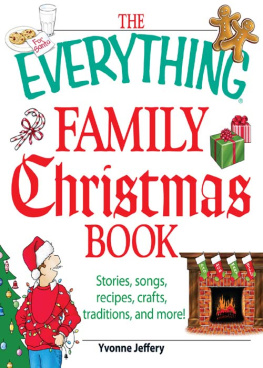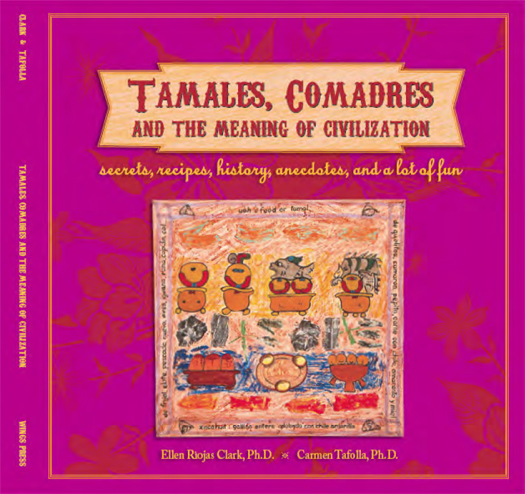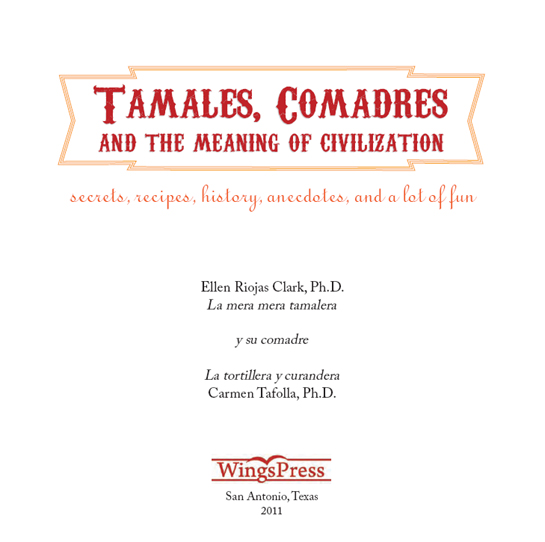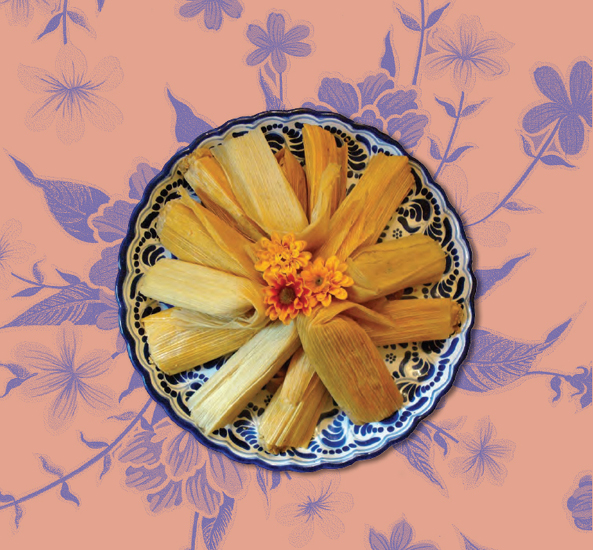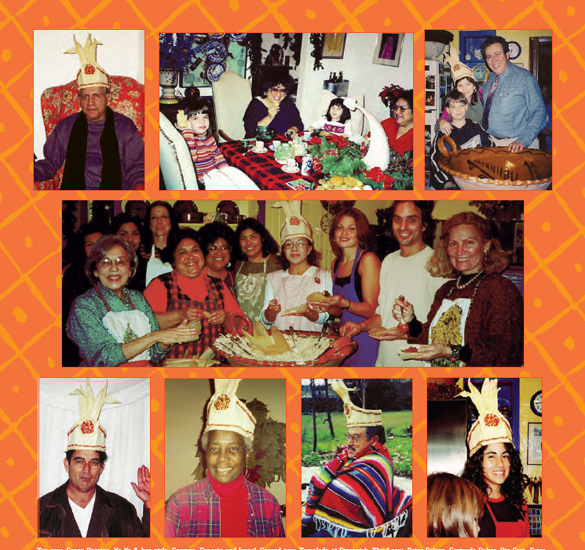Tamales, Comadres, and the Meaning of Civilization 2011
by Ellen Riojas Clark and Carmen Tafolla.
Designed by Thelma Ortz Muraida
Printed Edition ISBN 978-0-916727-81-9
ePub ISBN 978-1-60940-132-0
Kindle ISBN 978-1-60940-133-7
Library PDF ISBN 978-1-60940-134-4
Published by
Wings Press
627 E. Guenther
San Antonio, Texas 78210
Phone/fax: (210) 271-7805
On-line catalogue and ordering:
www.wingspress.com
All Wings Press titles are distributed to the trade by
Independent Publishers Group
www.ipgbook.com
and in Europe by
www.gazellebookservices.co.uk
All rights reserved. No part of this book may be reproduced, except for
brief excerpts for critical and review purposes, without written permission of the authors.
In 2009, a smaller version of this work was printed in a limited edition
in support of the Guadalupe Cultural Arts Center.
COVER ART: Tamales, Tamales, Tamales (1998, acrylic and ground chile on tablecloth) by Rolando Briseo represents all of the tamales he found, tasted, touched, and researched in his travels throughout Mexico, in mercados, cocinas, and old and new texts. Whenever he came upon a new tamal he would buy two, one to eat and one to paint. A special pilgrimage to the Huasteca region found the zacahuil, the 3 foot long tamaln that Fray Bernardino de Sahagn mentions in his writings as having an entire chicken in its center. The word hua means tamal and food in Mayan. Briseo reproduced glyphs and the ancient depictions of tamales from codices, and also painted a Mayan receptacle made especially for tamales with three separate indentations, for three different sauces. Some of these tamales are literally impressed on the tablecloth for the painting. This painting is from the series Moctezumas Table which will be published as an art book of the same title by Texas A & M University Press in 2010.
To Olga Kauffman and Thelma Ortiz-Muraida, true MTAs
(Masters of Tamalada Art)
without whom the physical reality of this book would have never happened,
for they inspired the textual shucks,
gathered the monetary shucks,
shaped the layout shucks,
designed the visual shucks,
found the printing shucks,
and made this tamalito happen.
E.R.C.&C.T.
W elcome to our cocina
and to our corazn.
Join us as we explore the timeless
meaning of gathering together
with family and friends
to celebrate survival
and love.
I NTRODUCING C IVILIZATION!
S o what do tamales and comadres have to do with civilization? Everything! As you unwrap those delicious, steaming, freshly-made tamales, gift-wrapped in corn shucks, that have kept human beings alive for more than seven thousand years on this continent, think about the things that last beyond nations, beyond languages, beyond flags. Our history and our stories are wrapped in those shucks, and our memories are wrapped in their love.
As a gift to all of you who ever dipped your hands in the magic masa, or who ever tasted its miraculous results, we three comadresEllen, Carmen, and Thelmabring you this tamalada of touching stories and hilarious mishaps, hints, secrets, jokes, recipes, poems, blogs, and celebrity quotesas pieces of our history and pieces of our hearts.
This book can best be described as a collaborative labor of love, which, just like a tamalada, requires laughter, tears, chisme, an intense amount of work, and a sense of wanting to feed a whole pueblo hungry to read about their culinary and historical hojas. It is a symbol of the giving our mothers and grandmothers did to feed us physically and spiritually. And if you wonder how this book came about, it was, very fittingly, out of that same sense of crazy comadrazgo and caring for the comunidad.
Ellen had spent 40 years hosting tamaladas at her house (see En Casa con Ellen, p. 12) and wanted to do something to honor her tas, her ancestors, and her descendents. Carmen wanted to do something to help her comadre Ellen be recognized for this work of cultural preservation and celebration, and to help her cultura document its cultural treasures, Thelma wanted to visually translate Carmen and Ellens literary work into the format it deserved, to reflect the tablecloths and the hojas, and the celebration, the warmth, and smiles of tamaladas. And all three comadres wanted to benefit a community institution that has long celebrated the arts of San Antonios West Sidethe Guadalupe Cultural Arts Center. So, totally without any re-payment for their intense tamalada-type labor, in November of 2009, they decided to donate all proceeds from the first limited edition to the GCAC. The entire book was written, assembled, designed, proposaled, funded, edited, and printed within four miraculous weeks of four comadres working late into the night, as Olga Kauffmann researched, prepared for and landed the generous donation of Valerie Gonzales, CEO of Delicious Tamales.
As if this wasnt enough of a miracle, Ellen talked Rolando Briseo into lending us his brilliant illustration Tamales, Tamales (see Cover Art credit on copyright page) and we leaned on the help of many a San Antonio genius (Robert Flynn, Antonia Castaeda, and Cary Clack, to name a few ) to pull together a book that truly represented the human aspect of tamales and tamale-making. In the process, we garnered everyones favorite story or favorite tamal, including the memories and magic moments from Vicky Carr and Arturo Sandoval to El Curro, the Krayolas, Sandra Cisneros and Hints from Heloise!
The books, like a batch of steaming hot tamales, were finally ready on December 18, 2009 and, like any good batch of tamales, they disappeared! Within three days, the books were sold out! People bought five or six at a time, or a dozento send off to Missouri or Wisconsin or to their grandmother in El Paso! People searched everywhere for copies, and one person reported finding theirs at an obscure raspa stand in West Texas! So, Wings Press came to the rescue and promised to bring to el pueblo and the world this much expanded trade edition.
May you unwrap these hojas with pleasure and the humbling awareness that they hold within them all the fun and flavor of 7,000 years of history and all the meaning of civilization!
E N C ASA CON E LLEN
W elcome to one of my Christmas Tamaladas to learn how to make this traditional favorite. I have been making tamales for over 40 years with family and friends at Starpatch, our home here in San Antonio. Though my mother, a wonderful and fancy cook, never made tamales, I did learn from a wonderful set of aunts. It was a childhood tradition to go over to my Dads family home on Mistletoe Avenue for Open House on Christmas Eve for tamales and my favorite pecan refrigerator cookies.


